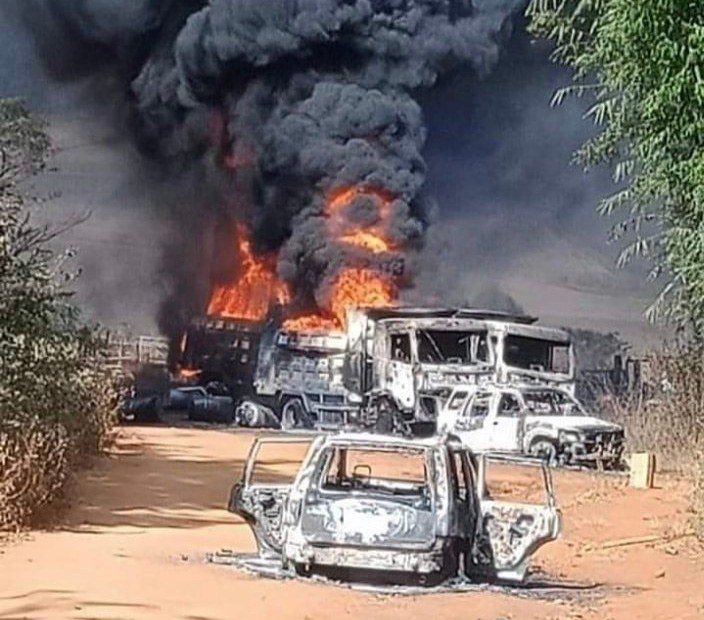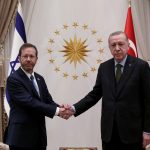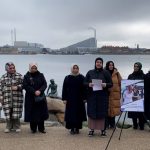Junta troops have burned more than five dozen civilians to death since the end of December in three regions of Myanmar where they have encountered heavy armed resistance to military rule, sources in the regions said Wednesday.
Residents told RFA’s Myanmar Service that at least 65 people had been set on fire and killed in the 10 weeks leading to March 7, including 35 and three in Kayah state’s Hpruso and Demoso townships, and five in Magway region’s Gangaw township.
In the Sagaing region, troops burned 10 people to death in Salingyi township, four in Ye-U township, three in Kalay township, and five in Myinmu township, they said.
Fighters with the anti-junta ethnic Karenni State Police (KSP) in Kayah state told RFA that over the same period, “at least 49 people were burned to death” in Hpruso’s Moso village, including 45 civilians and four members of the prodemocracy Karenni Nationalities Defense Force (KNDF) paramilitaries who operate as border guards in the area.
In one incident, on Feb. 24, residents of Sagaing’s Kalay township discovered the charred bodies of a woman and her two young children who had been detained by the military the previous day. The father of the two children told RFA he was only able to identify the remains after seeing his daughter’s earring.
Myanmar’s military has killed at least 1,640 civilians since seizing power in a Feb. 1, 2021 coup and arrested nearly 9,560 others – mostly during peaceful anti-junta protests.
The junta has mounted a series of major offensives against armed ethnic groups and anti-junta People’s Defense Force (PDF) paramilitaries in the country’s remote border regions in recent that have seen troops commit acts of rape, torture, arson, and murder against civilians, according to reports.
In the typical pattern in the conflict, after firefights with local anti-junta militia fighters, regime troops raid villages suspected of harboring resistance groups and burn all structures after stealing livestock, food and valuables.
Residents of Gangaw township’s Shwe Bo village told RFA that a combined forced of military troops and pro-junta Pyu Saw Htee militia members killed two people with gunfire and burned five people to death during a raid there on Feb. 28.
A villager who spoke on condition of anonymity said that atrocities like those committed in Shwe Bo and elsewhere were driving civilians toward armed resistance against the junta, rather than frightening them into subservience.
“The villagers know nothing but anger and want to strike them back,” he said.
“We might face punishment in the future, but for now, we will do whatever it takes to get rid of them. We want to see them eliminated by either [the shadow National Unity Government] NUG or any other group.”
In Salingyi township’s Done Taw village, where the burned bodies of ten people – including four ranging in age from 14 to 17 – were discovered following a military raid in December, another source who declined to be named told RFA that residents want to see the perpetrators sentenced to death when a civilian government is returned to power.
“If the people’s government takes control, we want to see the crimes of the junta and everyone who killed innocent people exposed,” he said. “We want to see the people responsible for these brutal murders to pay for them.”
 Demanding justice
Demanding justice
When asked about military acts of arson and reports of civilians being burned to death, junta Deputy Information Minister Major Gen Zaw Min Tun denied that troops were responsible.
“We have no reason to do that when we are protecting the civilians, as is our duty,” he told RFA.
“In Sagaing region, terrorist groups calling themselves the PDF are forcing local people to engage in terrorist activities. Many villages in the region have formed militia groups to protect themselves against NUG and PDF terrorist groups. The terrorists from the PDF attack the villages and burn them down.”
However, a surgeon who claimed to have inspected the victims of what has been dubbed the “Christmas Eve Massacre” of 35 people in Hpruso township’s Moso village called the killings a “deliberate act of brutal murder” by the military in a Jan. 3 press conference held by the NUG.
He described the bodies as having their hands tied behind their backs and mouths gagged; missing parts of their skulls, genitals, and chest; and burned so badly that their internal organs had disintegrated. It is believed some victims were killed before being set on fire.
Rights activists and medical experts have said those responsible for the burning deaths intended to eliminate the evidence of their actions.
Phoe Phyu, a human rights lawyer, told RFA that the perpetrators of such atrocities will be prosecuted under Myanmar’s Criminal Penal code.
“For the time being, the testimony of witnesses and evidence shall be collected to later find justice for the victims – this is called transitional justice” he said.
“One day when a government elected by the people comes to power and takes responsibility, it will open the door for securing such transitional justice.”
The NUG has vowed to launch an investigation into the deaths with the assistance of the international community.
New information about the number of civilians burned to death by junta troops came as research group Data for Myanmar reported that, as of Monday, the military had used arson to destroy a total of 6,719 homes in 186 locations across nine regions and states since last year’s coup.
The group, which documents the impact of conflict in Myanmar, warned in a statement on Wednesday that its report was compiled from publicly available data sources and excludes incomplete records, suggesting that the actual figures on military arson incidents may exceed the reported data.
Reported by RFA’s Myanmar Service. Translated by Ye Kaung Myint Maung. Written in English by Joshua Lipes.
Source: Radio Free Asia



